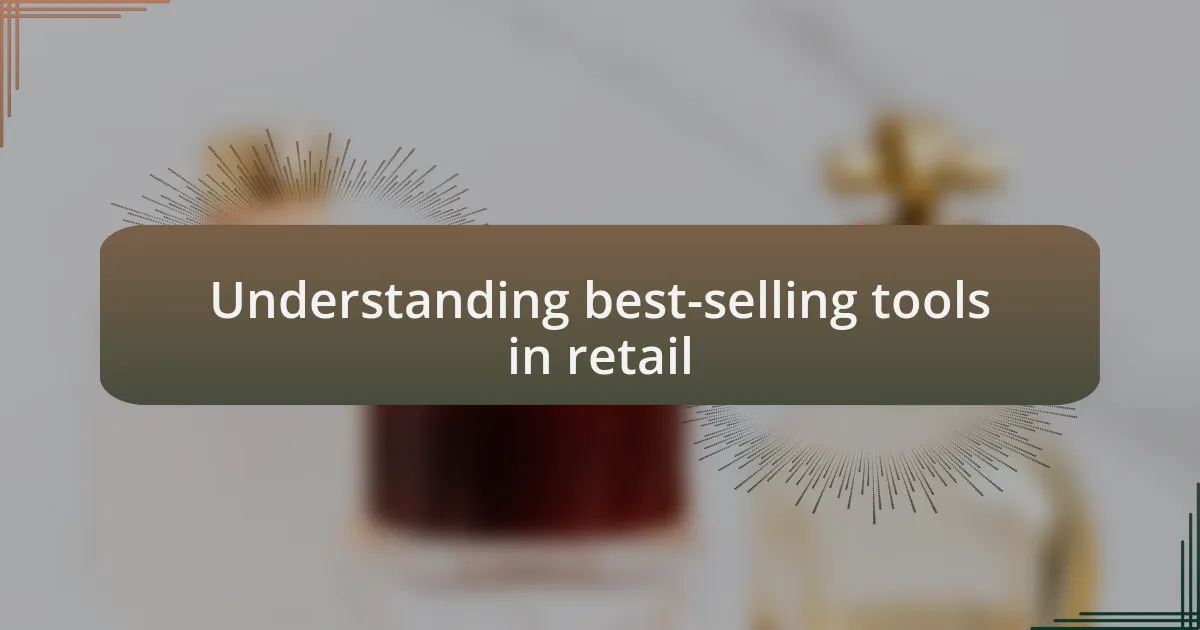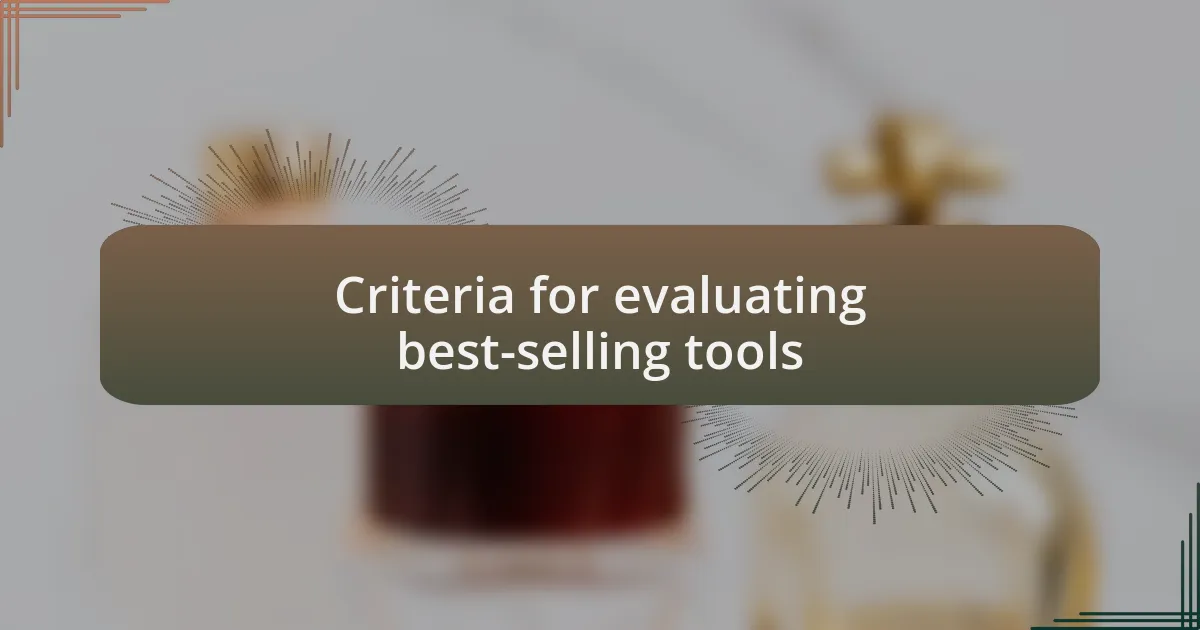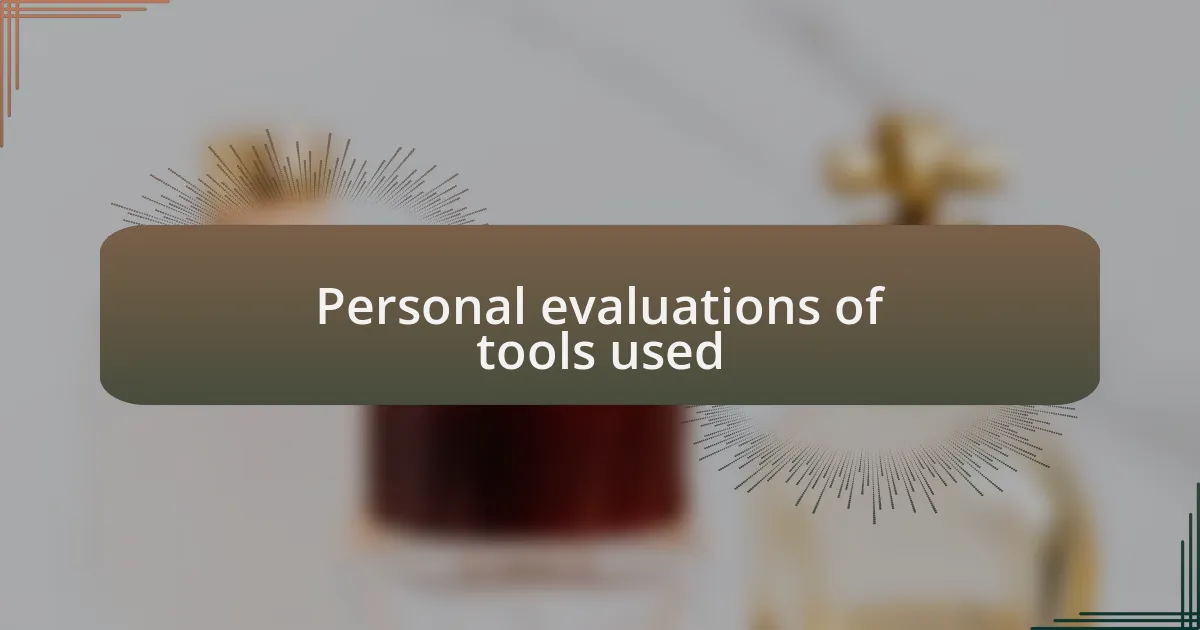Key takeaways:
- Implementing loyalty programs and personalized marketing strategies can significantly enhance customer retention and increase sales.
- Evaluating tools based on functionality, integration capabilities, and customer support is crucial for maximizing their effectiveness.
- Sales data analysis and customer demographics are essential for optimizing inventory and marketing strategies, especially in response to seasonal trends.
- Regularly assessing the tools in use can improve workflow and customer engagement, ensuring alignment with business goals.

Understanding best-selling tools in retail
In retail, best-selling tools are essential for maximizing sales and creating a memorable shopping experience. For instance, I once implemented a loyalty program that not only increased repeat customers but also fostered a sense of community among them. Have you ever noticed how a simple rewards system can turn a casual shopper into a loyal patron?
Analyzing what drives sales is a continuous journey. I remember being surprised by how effective personalized marketing could be; a targeted email strategy led to a significant boost in quarterly sales. It’s fascinating to think: how can something as simple as using a customer’s name in a message create such a personal connection?
Ultimately, understanding the effectiveness of various tools like point-of-sale systems, customer relationship management software, and engaging display techniques can transform the retail landscape. When I first explored using analytics to identify trends, it opened my eyes to patterns I’d overlooked before. Isn’t it empowering to realize that these tools can genuinely reshape your entire approach to selling?

Criteria for evaluating best-selling tools
When evaluating best-selling tools, one crucial criterion is functionality. I once tested a sales tracking software that promised robust features but was surprisingly clunky to use. I quickly learned that if a tool isn’t user-friendly, it compromises adoption rates and ultimately sales performance. Have you ever regretted investing time into a complex tool that just added more hassle than value?
Another significant factor is integration capabilities. In my experience, finding tools that seamlessly integrate with existing systems can make a world of difference. I implemented an inventory management system that synced perfectly with our e-commerce platform, streamlining operations and minimizing errors. It made me realize how vital it is to assess how well a tool fits within your existing ecosystem.
Lastly, customer support and training can’t be overlooked. I remember when we adopted a new customer relationship management (CRM) tool, and the initial learning curve was steep. But with responsive support and comprehensive training, the transition became much smoother, allowing my team to harness the system’s full potential. Have you considered how ongoing support can be a game-changer in your tool evaluation process?

Top tools for perfume retailers
When it comes to tools for perfume retailers, one standout option is an advanced point-of-sale (POS) system. I remember the first time I switched to a modern POS; the real-time sales insights transformed my ability to respond to trends. Isn’t it amazing to see how a system that tracks sales trends can help tailor your inventory to what customers are genuinely interested in?
Another tool I’ve found invaluable is a digital marketing platform aimed specifically at retailers. One holiday season, I leveraged targeted email campaigns that not only boosted sales but also created lasting customer relationships. Have you ever felt that special connection with a brand? That’s the power of personalized communication, and the right tools can help foster that feeling.
Lastly, an effective loyalty program management tool has proven essential for retaining customers in the perfume retail space. I recall how implementing a points-based system led to increased repeat visits and a stronger brand loyalty. It makes you think—how are you currently rewarding your customers, and could a loyalty program elevate their shopping experience? Engaging tools like these significantly shape the retail landscape and create a more dynamic connection with your clientele.

Analyzing sales data for tools
When I delve into sales data for tools, I pay attention to trends that can give me a competitive edge. For instance, last year, I noticed a significant spike in sales during a specific fragrance launch. This insight allowed me to adjust my marketing strategies and double down on promoting similar scents. Have you ever analyzed data and found a hidden gem that you could capitalize on?
I’ve also learned to segment sales data based on customer demographics. For example, when I realized younger customers preferred fresh, fruity notes while older customers leaned towards classic fragrances, I adjusted my inventory accordingly. Isn’t it fascinating how understanding your customer base can inform your choices and lead to better sales outcomes?
In analyzing seasonal data, I discovered that certain fragrances perform better during specific times of the year. During last holiday season, I ran a special promotion on popular winter scents and saw a remarkable increase in sales. This experience taught me that timing, combined with data-driven insights, can significantly impact a retailer’s success. Don’t you think it’s crucial to align your offerings with what customers desire at a given moment?

Personal evaluations of tools used
When I assess the tools I use for evaluating sales, I reflect on the simplicity that some tools provide. Recently, I integrated a sales tracking software that not only streamlines data entry but also visualizes trends beautifully. I can’t help but feel a sense of satisfaction when I watch those charts illuminate spikes in sales—it’s like unlocking a new layer of my business. Have you experienced that moment of clarity when technology reveals insights you hadn’t seen before?
In my experience, customer feedback tools have proven invaluable. After implementing a survey system, I discovered customers were seeking more eco-friendly packaging in their orders. This insight spurred me to dive deeper into sustainability, leading to not just better customer satisfaction but also a stronger brand identity. Isn’t it intriguing how one piece of feedback can spark a transformation in your approach?
I’ve also experimented with inventory management tools, which have been a game changer for my stock levels. There was a point where I panicked over running low on a best-seller—only to realize I could have anticipated the demand with better predictions. Now, I simply review my tool’s insights regularly, which grants me peace of mind as I navigate restocking. Doesn’t the right tool make you feel more in control of your business?

Final thoughts on selecting tools
When it comes to selecting the right tools, I’ve learned the importance of aligning them with my business goals. For instance, I once chose a marketing automation platform purely based on its flashy features, only to realize it didn’t integrate well with my existing systems. Have you ever rushed into a decision only to find it complicates rather than simplifies your processes? Reflecting on that moment taught me that functionality trumps aesthetics.
I also pay close attention to how user-friendly tools are. There was a time I invested in a complex analytics suite that bewildered my team, leading to frustration rather than insight. I now prioritize tools that my staff can navigate with ease, because if they struggle, the entire organization suffers. Doesn’t a seamless user experience enhance productivity and let you focus on what really matters—growing your business?
Lastly, I find it essential to continuously evaluate the impact of each tool I use. I recall when I cut ties with one overly complicated CRM; it liberated my team’s workflow and significantly improved our customer engagement scores. How often do we overlook the need to reassess our tools? Regular evaluations not only enhance performance but also ensure that we adapt to our ever-evolving industry landscape.